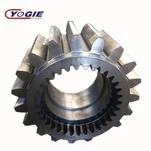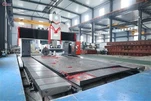
Making a girth gear involves several parameters that are crucial for ensuring its functionality and durability.
here's A List of some important parameters
Material Selection: Choose a material suitable for the intended application, typically alloy steel or cast steel with high strength and wear resistance.
Tooth Profile: The tooth profile, such as spur, helical, or herringbone, is selected based on the application requirements, load, and operating conditions.
Module: Module refers to the size of the teeth and is determined based on the diameter of the gear. It's important to select an appropriate module to ensure proper meshing with the pinion.
Pitch Diameter: The diameter at which the gear teeth are spaced. It's calculated based on the number of teeth and the module.
Number of Teeth: Determined based on the application requirements, load distribution, and desired gear ratio.
Pressure Angle: The angle at which the gear teeth are cut. Common pressure angles are 14.5° and 20°. The selection depends on factors like load distribution and tooth strength requirements.
Backlash: The clearance between mating gears. Proper backlash is necessary to prevent binding while ensuring smooth operation.
Face Width: The width of the gear teeth. It's crucial for distributing the load evenly and ensuring sufficient contact area.
Hardness: Girth gears are usually hardened to increase wear resistance. Proper hardness ensures longevity and resistance to surface fatigue.
Tooth Accuracy: Precision in tooth profile and dimensions is essential for smooth operation and minimal noise.
Heat Treatment: Heat treatment processes such as carburizing and quenching are applied to increase hardness and strength.
Quality Control: Strict quality control measures are necessary throughout the manufacturing process to ensure dimensional accuracy, surface finish, and overall quality of the gear.
Surface Finish: The surface finish of the gear teeth influences friction, wear, and noise levels. Proper surface finish is essential for efficient operation.
Gear Lubrication: Consideration of lubrication requirements to reduce friction, wear, and heat generation during operation.
Mounting Arrangement: Design considerations for mounting the girth gear onto the rotating equipment, ensuring proper alignment and support.
Testing and Inspection: After manufacturing, thorough testing and inspection procedures are essential to verify the gear's quality, dimensional accuracy, and performance characteristics.







